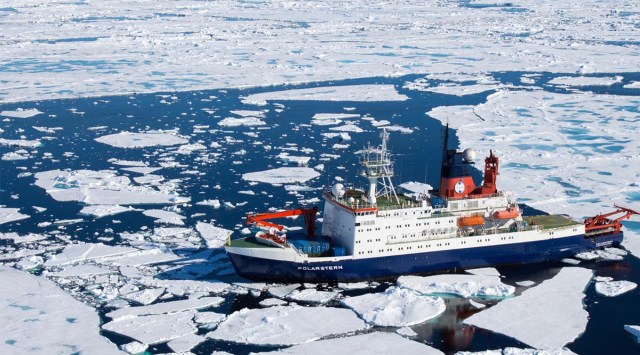Biologists discover bacteria living in ‘smoke’ of underwater volcanoes in the Arctic ocean
Microbiologists have found a species of bacteria that thrives in the plumes of hot fluid rising from underwater hydrothermal vents in the Arctic ocean.
 The microbiologists embarked on a trip in the vessel Polarstern, pictured here, to collect samples. (Image credit: Alfred Wegener Institute / Stefanie Arndt)
The microbiologists embarked on a trip in the vessel Polarstern, pictured here, to collect samples. (Image credit: Alfred Wegener Institute / Stefanie Arndt) “Life, uh, finds a way” is more than just a memorable quote by Jeff Goldblum’s character in Jurassic Park. German scientists discovered the truth in that statement while on a research mission to the Arctic region where they found bacteria thriving off the “smoke” from underwater volcanoes.
At tectonic plate boundaries deep under the ocean, there are “hydrothermal vents” from which hot fluids rise. These fluids don’t have any oxygen but they contain large amounts of metal like iron, manganese, or copper. Some of these fluids also transport sulfides, methane and hydrogen.
These plumes ascend hundreds of metres up from the seafloor and disperse thousands of kilometres away from the source. While these plumes could be hazardous to most lifeforms, that does not stop a certain bacteria from thriving there, according to the Max Planck Institute of Microbiology.
“We took a detailed look at bacteria of the genus Sulfurimonas. It was assumed that they were flushed there from seafloor vent-associated environments. But we wondered whether the plumes might actually be a suitable environment for some members of the Sulfurimonas group,” said Massimiliano Molari from the institute, in a press statement. Molari is the first author of a research paper on the bacteria published in Nature Microbiology.
In order to sample these hydrothermal plumes, the researchers took a challenging sampling trip to hydrothermal plumes in the Central Arctic and South Atlantic Ocean. The researchers sampled plumes in extremely remote areas where collecting them was difficult because these plumes are located at depths of more than 2,500 metres below the Arctic sea ice.
After collecting the samples, they identified a new Sulfurimonas species called uSulfurimonas pluma where the “U” is a superscript that stands for uncultivated. This new species inhabits those cold hydrothermal plumes.
Interestingly, these microorganisms used hydrogen from the plume as an energy source, rather than sulfides. The scientists then investigated the microbes’ genomes and found them to be strongly reduced; missing genes that are typical for their relatives. But while they missed many typical genes, they had many others that allowed them to grow in the challenging environment.







